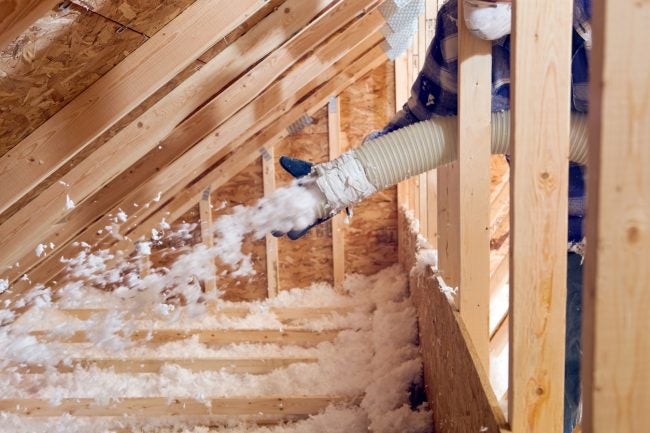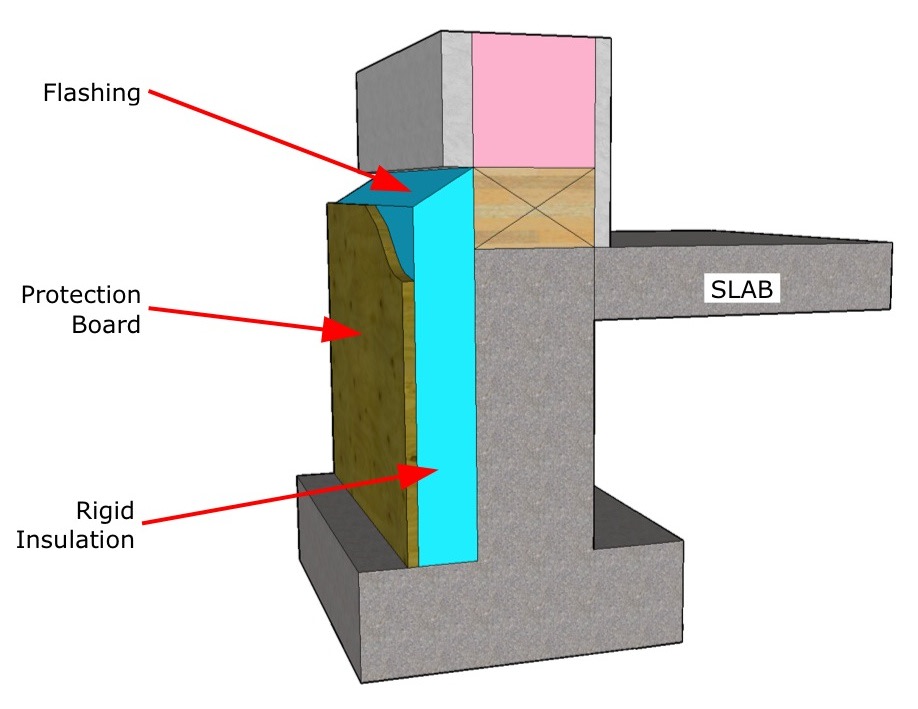Best Places to Insulate a Home
Date Published: February 1, 2022
Where are the best places to insulate a home to get the most energy savings and best comfort gains? That question is asked in every energy audit we perform. While this answer can vary depending on the age and the type of home, there are general solutions that apply across the board.
Improvements in the insulation and air sealing of a home are always the first things you want to do when looking into home energy savings. Before you even consider the efficiency of the heating and cooling systems, your insulation should be evaluated and addressed accordingly.
Let’s take a look at the best places to insulate a home.
Attic-Ceiling
By far, without any doubt, insulating the attic or ceiling of the home is the number one priority. The largest amount of heat is gained and lost through the lid of a house.
During the winter, as heat is generated, there is a large difference in interior vs exterior temperature that needs to be maintained.
In cold climates, you may have days that are in the 20s or 30s outside. If you are trying to maintain a comfortable temperature of 70 degrees inside, that is a 40-50 temperature differential. And if you remember any science from high school, you know heat tries to move to cold.
Also, that hot air rises. As the heat produced rises, heat is lost through conduction along the ceiling surfaces. The drywall or ceiling material heats up and conducts that heat through the surface and out of your home.
If the insulation layer at the ceiling is inadequate, there is no resistance to that heat loss, and there goes your cozy house. The opposite is true in summertime conditions. As the sun beats down on the home, the roof material heats up, and the attic gets hotter. If the insulation layer is inadequate, the heat can conduct right through the ceiling into the home.
That’s why ceiling insulation is the top priority when upgrading your home’s energy efficiency. If there is attic space above the ceiling, then you have an opportunity to evaluate the insulation layer and determine if more insulation is needed.
Insulation is rated by its resistance value or R-Value. Along the Front Range of Colorado, it is recommended that homes have at least R-54 insulation value. This recommended level of R-54 is an upgrade from past recommendations, so very few homes in our region currently have this much insulation present.
If you are evaluating your own attic, the most common insulation types used in attics is either fiberglass (blown or batt type) or blown-in cellulose. Both of these insulation types are similar in their ratings at approximately an average of R3.5/inch. So to reach a value of R-54 you would need roughly 14-15 inches of insulation present.
When you have an attic space present, adding more insulation isn’t difficult. An insulating contractor or even a handy home-owner can carefully add more insulation. This is typically done by using a large blower tool that pushes raw insulation material through a tube which is slowly applied throughout the attic. These tools are owned by professionals, but smaller versions can be rented at hardware stores.
There are some important rules to follow while insulating. Maintaining good ventilation in an attic and not blocking off any soffit venting should be considered. Also, you have to be careful to not fully cover can-lights and other fixtures should not be covered.

Image sourced from Bobvila.com
There are also considerations with air sealing that should be evaluated prior to insulating that we won’t cover in this article, but we have some great information in this air-sealing post. We recommend you have a blower door test done as part of an Energy Audit and seal air leaks in the ceiling prior to adding insulation.
Vaulted ceilings represent a bigger challenge. Depending on the size of the wood framing used in the vaulted area, there may be limited space available. Adding insulation may not be possible in these areas if the height is limited and the cavities are already full of insulation.

Picture sourced from Pacific Insulation Supply
In that case, air sealing any leaks where heat can escape is the only solution. Unless you are performing a remodel and removing the drywall or ceiling material in these vaulted areas. If that happens you have an opportunity to re-insulate and potentially consider higher density insulation that has a greater R-Value per inch, such as spray foam material.
Bottom line, insulating the ceiling and attic areas is by far the number one best way to improve the comfort of your home. The greatest comfort benefits and energy savings will be seen by adding insulation to the ceiling areas.
Basement-Crawlspace-Slab
Dropping to the bottom of a home, the next best place to insulate is the lowest level of your home. Once again, if we look at wintertime conditions, the lowest level of the home has a large part to play in reducing heat transfer.
This works in tandem with attic insulation. As heat rises in a home and is lost through the ceiling, the home then pulls in cold air or conducts colder temperatures at the lowest level. This is what is commonly referred to as the chimney-effect or stack-effect.

Photo Sourced From Innovative Basement Authority
As heat rises, if you have poorly insulated areas at the base of the home, cold temperatures will conduct or air leaks will allow cold air into the home. This effect causes your heating system to run more and comfort imbalances occur in the home.
If the home is over a basement or a crawlspace, the number one place to review the insulation is in an area called the rim-joist. This is the area where the framing of the home extends below the main floor and connects to the top of the foundation. That “rim” of the home is where the coldest conduction and air leaks can occur.
Just as in the ceiling, ensure you have air leaks evaluated using a blower door test and potentially infra-red scanning, to find and seal all the air leaks first. This should be followed up by insulating this area as best as possible.

Today’s building standards along the Front Range call for R-19 minimum along the rim joist area. Many older homes have no insulation present in the rim-joist areas and we often see lots of air leakage.
In addition to the rim-joist, it is advisable to insulate the concrete foundation walls as well. As most of us intuitively know, basements can be cold and damp. Much of this colder feeling in a basement comes from conduction through the concrete, even where much of the wall is below grade.
A steady earthen temperature causes a basement wall to sit much colder than internal temperatures. This cold conduction of the walls moves into the home and further pushes the heat upwards and out of the home. So insulating the basement walls with an R-19 insulating layer helps tremendously.
We recommend that you treat a crawlspace as a mini-basement. Insulate the rim-joist and concrete walls to the same recommended levels as the basement. Often plumbing pipes and heat ducting are present within the crawlspace and if you insulate the under-floor only, you now have isolated those items outside the thermal boundary.

Image Sourced From Foundation Recovery Systems
By treating the crawlspace as a mini-basement, you encapsulate those items within the boundary and prevent freeze issues. You also need to be attentive to the floor of the crawlspace. If it is dirt, this needs to be covered with a plastic sheet vapor barrier and sealed to keep moisture levels out of the crawlspace. Another consideration covered in a separate article is to seal ducting to prevent losses in a basement or crawlspace. These techniques are known as “conditioning” your crawlspace. This makes the area part of the heated envelope of the home and makes for a much more comfortable living environment.
If your home is built over a concrete slab, this gets more challenging to insulation. The best solution that can be considered is to insulate the exterior edge of the slab with foam board insulation.
This can be difficult if the edge is buried and would involve excavating around the slab edge. But a decent amount of cold conduction occurs on concrete slabs and much of it comes along the exposed edge at the soil. A 2-inch layer of foam board that is roughly R-10 insulating value can go a long way toward reducing cold conduction along concrete slab edges.

Image sourced from NACHI
Walls
The third area of consideration is the level of wall insulation in the home. This is also the most challenging area to insulate on an existing home, but because of the stack effect, and the loss or gain of heat and cold at the ceiling and floors, the walls really are the third priority.

Image Sourced from www.energyvanguard.com
In Colorado, the current recommended insulation level in walls is R-20 insulation value. On new construction, this is achieved by the use of 2×6 wood framing. Many older homes only had 2×4 framing which typically had R-11 or R-13 insulation present. Unfortunately, if the home was built in the 1940s or 1950s, it may have R-0 in the walls, as in NO insulation. What were we thinking?!
The first step is to find out what you have in your walls. An energy auditor can view into wall cavities by removing electrical outlets or switch covers and carefully trying to see what insulation level and type is present. The use of infra-red scanning can also give a basic idea of what may be present. Naturally, if any level of remodeling is done that involves removing the inside wall material, you can get a look at what is present as well.
Adding insulation into walls is limited to a couple of options. If you are considering a remodel, and you know there is limited insulation in the walls, consider removing the interior drywall or surface material and adding insulation. The added cost to re-do drywall is small compared to the gains in comfort and energy savings with properly insulated walls.
Another option is to have insulation blown into the walls. An insulating contractor can inject insulation into wall cavities by drilling holes either on the interior or exterior and blowing insulation into each cavity. This does involve drilling a lot of holes, one for each 16″ spaced wall cavity. But the benefit is that the process is much less invasive than removing all interior wall surfaces. This can be done whether some amount of insulation is present or none.
Those 3 primary areas represent the best places to insulate a home. Certainly, there are discussions that need to be had about the quality and performance of the windows, and as we discussed, the air-sealing opportunities. But insulating in these 3 areas along with proper air sealing can have a dramatic impact on the comfort and energy savings in a home.
A complete energy audit will review insulation levels in all these areas and make recommendations for where upgrades are needed. Other aspects of an energy audit will address the window performance, heating and cooling system performance, water heating system, and other areas of potential energy savings.
We definitely recommend you take a big picture approach to energy savings and work out a priority list of actions that come from an energy audit. However, adding insulation where needed is likely going to represent the most cost-effective means of gaining added comfort and improving energy efficiency in a home.
Related Articles
If you enjoyed this article, you may be interested in some of our others.







